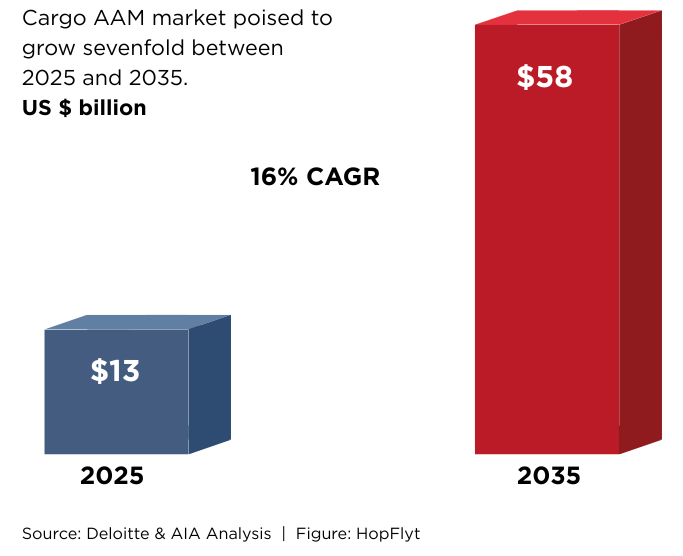AN INVESTMENT IN THE FUTURE OF AVIATION
HopFlyt is redefining how cargo moves today – offshore, onshore, and beyond. Our patented hybrid-electric VTOL aircraft unlock new possibilities for long-range, uncrewed logistics across commercial and defense markets.
What Makes HopFlyt Different
Advanced Technology
HopFlyt’s patented Channel Wing hybrid-electric platform redefines what’s possible in VTOL flight, creating a new class, and setting a new standard for efficiency and performance. With our hybrid power system and world-class partners, we’re ready to scale and lead the next generation of Advanced Air Mobility (AAM).
Learn More >
Organizational Efficiency
HopFlyt has advanced to its current stage with less than 10% of the funding typical for comparable AAM competitors. Our lean model, shaped by decades of aerospace expertise, and partnerships with proven, best in class suppliers, including UAV Turbines and Aerodine Composites, accelerates development and gives us access to advanced systems and support without heavy internal overhead.
Learn More >
WORLD-CLASS team
Based in Maryland, our team combines elite aviation engineers, former NASA and military test pilots, and executive leaders from Fortune 500 and advanced manufacturing backgrounds. Together, we bring 100+ years of aerospace and operational experience, the vision, discipline, and technical depth to deliver where others stall.
Meet The Team >
Dual Use Capabilities
HopFlyt’s aircraft is built for true dual-use deployment, focused on uncrewed cargo today, with a clear path toward expanded applications tomorrow. From offshore energy and naval resupply to medical logistics and ISR, HopFlyt supports missions that demand autonomy, range, and reliability. As our fleet evolves, so will our capabilities, enabling future solutions in passenger transport, cargo, and other autonomous operations.
Learn More >
Why now: The Market is Taking Off

The global demand for safe, efficient, and scalable logistics has never been greater. From offshore energy to national defense, operators need aircraft that can reach places traditional options can’t, without the cost, risk, or emissions.
The Advanced Air Mobility (AAM) market will rival artificial intelligence. Morgan Stanley predicts a $1 Trillion global TAM by 2040 growing to $9 Trillion by 2050. For the next 10 years, industry experts predict the deployment of AAM technology will be in unmanned cargo delivery as the passenger aircraft market emerges [1] [2].
[1] Deloitte and AIA Analysis Advanced Air Mobility, Deloitte, 21 January 2021
[2] Morgan Stanley Research eVTOL/Urban Air Mobility TAM Update: A Slow Take-Off, But Sky’s the Limit, Morgan Stanley, 6 May 2021
Don’t Take Our Word For It
“Advanced Air Mobility (AAM) is ushering in the third revolution in aerospace through the introduction of an emerging transportation system using highly automated aircraft with advanced technologies that promise a safe, efficient, affordable, and sustainable new way to travel.”
— U.S. Department of Transportation
“The vision of AAM is that of a safe, accessible, automated, and affordable air transportation system for passengers and cargo capable of serving previously hard-to-reach urban and rural locations.”
— NASA Statement
Built to Deliver. Designed to Scale.
- Purchase or lease HopFlyt aircraft for use in logistics, ISR, or other autonomous operations
- License our patented aircraft design and other core technologies for research, integration with third-party systems, or bespoke development
- Collaborate on government and defense contracts where dual-use capability is critical
HopFlyt is built for adaptability. Our aircraft and business model scale to meet the mission, whether that means offshore delivery or autonomous operations, HopFlyt delivers exactly what’s needed, where it matters most.
Investor Opportunity
We’re currently raising capital to complete hybrid-electric prototype development, initiate flight demonstrations, launch low-rate production, and complete first deliveries.
Whether you’re an early-stage investor, strategic defense partner, or fund looking at dual-use technology, we invite you to connect.